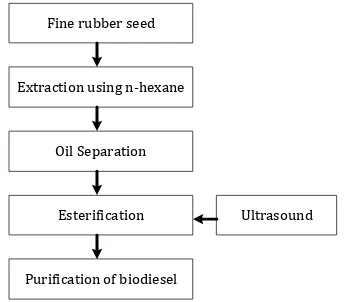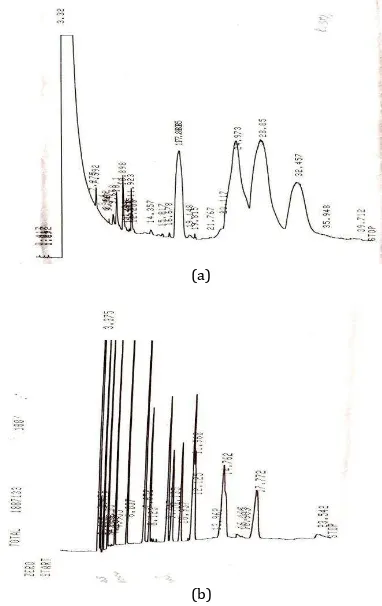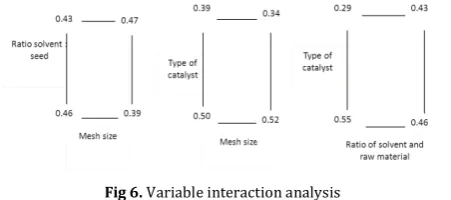Contents list available at IJRED website
Int. Journal of Renewable Energy Development (IJRED)
Journal homepage: www.ijred.com
Ultrasound Assisted Esterification of Rubber Seed Oil for Biodiesel
Production
Widayat
a*, Berkah Fajar Tamtomo Kiono
ba Center of Biomass and Renewable Energy, Chemical Engineering Department, Faculty of Engineering, Diponegoro University,
Jl.Prof Sudharto,SH-Tembalang, Semarang INDONESIA
b Mechanical Engineering Department, Faculty of Engineering, Diponegoro University,
Jl.Prof Sudharto,SH-Tembalang, Semarang INDONESIA
Article history:
Received December 21, 2011 Received in revised form Jan 8, 2012 Accepted January 17, 2012 Available online
ABSTRACT: Production of biodiesel is currently shifting from the first to the second generation in which the raw materials are mostly from non-edible type oils and fats. Biodiesel production is commonly conducted under batch operation using mechanical agitation to accelerate mass transfers. The main drawback of oil esterification is the high content of free fatty acids (FFA) which may reduce the yield of biodiesel and prolong the production time (2-5 hours). Ultrasonification has been used in many applications such as component extraction due to its ability to produce cavitation under certain frequency. This research is aimed to facilitate ultrasound system for improving biodiesel production process particularly rubber seed oil. An ultrasound unit was used under constant temperature (40oC) and frequency of 40 Hz. The result showed that ultrasound can
reduces the processing time and increases the biodiesel yield significantly. A model to describe correlation of yield and its independent variables is yield (Y) = 43,4894 – 0,6926 X1 + 1,1807 X2–
7,1042 X3 + 2,6451 X1X2– 1,6557 X1X3 + 5,7586 X2X3 - 10,5145 X1X2X3, where X1 is mesh sizes, X2
ratio oil: methanol and X3 type of catalyst.
Keywords: Rubber seed oil, Ultrasound, Esterification, Biodiesel, Yield
*
Corresponding author: Tel: +62-24-7460058 E-mail:[email protected]
1. Introduction
Nowadays, demands of fossil energy in Indonesia are significantly increasing while oil reserves will be diminishing within 20 years [1]. As a consequence, there are serious attempts in finding new alternative energy i.e. hydrogen cells, solar energy and wind power. However, the above technologies are still at the development stage, and still not feasible to be applied from economic point of view [2].
The feasible option is developing the technology for biodiesel production as it is biodegradable and non-toxic product. Biodiesel also has low undesirable emission, and environmental friendly. Biodiesel can be produce from vegetable oils which is generated from renewable resources. They practically have less sulphur content, offer no storage difficulty, and they have
excellent lubrication properties. Moreover, converting vegetable oils to become biodiesel indirectly can improve the absorption of carbon dioxide compare to the direct burning (conventional method in generating energy) [3, 4].
Rubber seed oil is one of vegetable oil which has high unsaturated fatty acids (80%) and thus makes this oil potential source for biodiesel raw material. High unsaturated fatty acid leads to high value cloud point and cetane number as the important properties of biodiesel [5].
P a g e | 2
Table 1
Rubber seed oil characteristic [5]
Property Rubber seed oil Sunflower oil Rapeseed Oil Soybean oil
Fatty acid composition
esters will increase the cloud point, cetane number and also will improve stability. In other hand, the excess of poly unsaturated may reduce the cloud point and cetane number and stability.
Trans-esterification (alcoholises) is the chemical reaction between triglycerides and alcohol in the presence of catalyst to produce methyl-ester and glycerine [4]. The overall trans-esterification reaction can be shown by the following reaction:
The glycerides are converted into glycerol and yielding one methyl ester molecule (FAME) which has properties comparable to biodiesel.
Production of biodiesel from vegetable oils i.e. soy, jatropha, sunflower seed or microalgae, using conventional process is relatively slow (almost 4-5 hours), it needs more catalyst and alcohol while the esterification reaction is not fully completed. Moreover, the high formation of by-product gives low yield of biodiesel and during the conversion process not all fatty acid chains are turned into biodiesel which consequently reduces the quality and the yield. The current conventional process only can achieve maximum yield of 85% during esterification reaction.
Normally, by stoichiometry, three moles of alcohol are needed for each mole of triglyceride, but in reality a higher molar ratio is used in order to get higher yield of ester product. Even though esters are the main products of the trans-esterification reactions, glycerine as the by-product is getting much attention due to its role in decreasing the conversion. Alcohol used in the reaction is normally methanol or ethanol however the yield of esterification is independent of the type of alcohol. The common alcohol used is methanol due its economical reason. Sulfic acid (H2SO4) is normally used for acid
catalyst while potassium hydroxide (KOH) and sodium hydroxide (NaOH) are the commonly used for alkaline catalysts. Alkaline catalysed trans-esterification of
vegetable oils is possible only if the acid value of oil is less than 4. Higher percentage of FFA in the oil will reduce the yield of the esterification process.
The free fatty acid (FFA) content of rubber seed oil is about 17%. The yield of esterification process decreases considerably if FFA value is greater than 2%. Trans-esterification would not occur if FFA content in the oil were about 3%. It has been found that the alkaline catalysed trans-esterification process is not suitable to produce esters from unrefined oils. Vegetable oils refining can increases the overall production cost of the biodiesel. Acid esterification is a typical method of producing biodiesel from high FFA oil [6]. But it requires high methanol and very time consuming.
Therefore, an alternative process is really required to reduce the processing time, to increase the yield, to lower amount un-reacted methanol and also catalyst, and to increase the mass transfer. Ultrasound (~20 kHz to l0 MHz) is cyclic sound pressure with a frequency greater than the upper limit of human hearing [7]. The ultrasound technique has been used for several applications such as extraction of xyloglucan from apple pomace [8]; extraction total fat from oleaginous seeds
[9, 10]; extraction of anthraquinones from roots of Morinda citrifoli [11]; extraction of Ilex paraguariensis leaves [12]; and leaching process of Geniposide [13].
The advantages of using ultrasound in trans-esterification process is that ultrasound generate bubble cavitation which replacing the mechanical agitation by stirrer, and therefore it is required for enhancing the esterification reaction [14, 15]. This paper describes the potential use of ultrasound for assisting biodiesel production using rubber seed oil.
2. Experimental Method
2.1. The procedure of experiment
and was esterified using methanol and catalyst. The ultrasound was facilitated to enhance the mixing instead of mechanical agitation. The biodiesel product was purified using distillation to separate from methanol and glycerol. The schematic diagram for biodiesel production was shown in Figure 2.
Fine rubber seed
Extraction using n-hexane
Oil Separation
Esterification
Purification of biodiesel
Ultrasound
Fig 2. The procedure to make biodiesel using ultrasound
2.2. Experimental design
This research conducted using experimental factorial design with 2 levels as shown in Table 2. The independent variable used in this research are temperature ( 400C ), pressure(1 atm), frequency (40
KHz), sample weight (50 gram), amount of catalyst (3 % weight), while the dependent variables are: mesh sizes (1 mm and 1,16 mm), solvent : oil ratio (2:1 and 3:1), type of catalyst (NaOH 1 N and H2SO4 98%).
Table 2
Factorial design for 3 variables
Run Variables B P K
1 - 1 -1 -1
2 +1 -1 -1
3 -1 +1 -1
4 +1 +1 -1
5 -1 -1 +1
6 +1 -1 +1
7 -1 +1 +1
8 +1 +1 +1
9 0 0 0
10 0 0 0
Remarks:
(+): Upper limit; (-): Lower limit, and (0): Centre value; B : Mesh sizes: 1 - 1,16 mm, with P: Ratio solvent: oil between 2 : 1 and 3 : 1 (w/w) with K: Type of catalyst: acid (-) and base (+)
To calculate yield of the extractive –reactive process, fatty acid methyl ester (FAME) was determined by using Gas Chromatography (GC). The yield was calculated from the weight of FAME in the product divided by oil content in the rubber seed oil. To determine effect of each variable, their interaction and significant effect of each variable, the factorial design of 2 levels was used
[16].
The equipment used in this experiment is shown in figure 3. This equipment was used for extractive reactive completed by ultrasound unit and distillation.
Fig 3. Ultrasound unit for esterification and distillation unit
3. Results and Discussion
3.1. Reactive-extractive process
At the stage of reactive-reactive process, triglycerides from rubber seed oil are converted to biodiesel and glycerol. The yield obtained from this process shows a promising result of applying ultrasound for esterification of rubber seed oil. The ultrasound can enhance the yield of biodiesel due to its cavitation for mixing and generating primary spot in the reactant (Table 3).
Tabel 3
Yield of esterification process
Run B P K Biodiesel (gr)
Yield (%)
1. - 1 -1 - 11,77 62,11082 2. +1 -1 - 9,14 48,23219 3. -1 +1 - 7,04 37,1504 4. +1 +1 - 10,40 54,88127 5. -1 -1 + 5,53 29,18206 6. +1 -1 + 5,63 29,70976 7. -1 +1 + 9,15 48,28496 8. +1 +1 + 7,27 38,36412 9. 0 0 0 6,29 33,19261 10. 0 0 0 2,82 14,88127
The ultrasound wave has a huge energy at the surface tension which is reciprocal to the bubble radius. This short radius can generate energy which force the process occurred at lower temperature, compared to conventional operation (60oC). Table 3 also shows that
extraction and esterification could be done simultaneously
In determining the significant variables in the production process of biodiesel, the factorial design method was used. The linear correlation from response surface methodology delivers following equation:
Yield = 43,4894 – 0,6926 X1 + 1,1807 X2– 7,1042 X3
+ 2,6451 X1X2– 1,6557 X1X3 + 5,7586 X2X3 - 10,5145
P a g e | 4
To determine significant and effect of interaction among variables, statistical analysis is required. Table 4 shows statistical analysis by using ANOVA method. The p value of each variable is greater than p in the table (p>0.05). Therefore, we assumed that all variables are significant and are not rejected as the model parameter. The equation shows that coefficient of X1 has a
negative value, meaning that high yield can be obtained by decreasing mesh sizes because surface area of mass transfer of oil from rubber seed to solvent is larger and therefore accelerate the mass transfer. In other hand, coefficient of X2 is positive, meaning that the yield can
be increased by using larger ratio of solvent. This is supported by [17] stating that molar ratio of substrate and methanol is one of important factors for trans-esterification process. In this experiment, molar ratio of methanol and rubber seed oil is 1:2 and 1:3. The highest significant parameter is coefficient of X3 namely type of
catalyst.
This equation shows that coefficient in front of X1X2X3 has larger value (10.5145) and therefore the
interaction among these variables is the most significant followed by coefficient of X3 (7.1042).
Therefore this variable is the second significant variable in the process.
Fig 4. The normal probability
Figure 4 shows probability and the significant effect of variables. The most significant variable is shown by the farthest point of I123. Therefore, the interaction of
three variables is the most significant in the production of biodiesel from rubber seed oil using ultrasound. The
second most significant affect is type of catalyst while the third is the mesh sizes.
The use of acid catalyst results a higher yield compared to base catalyst. This proved that rubber seed oil contains high FFA (16%) which needs to be decreased by using esterification reaction prior to trans-esterification using base catalyst.
Oil with FFA more than 2% should be avoided for trans-esterification processes otherwise this FFA will react with base catalyst through saponification process
[6, 17]. This condition leads to decreasing yield of biodiesel production and difficulty in separation. Figure 8 shows gas chromatography analysis result for biodiesel from rubber seed oil. Methyl esters in this sample are: methyl palmitate, methyl palmitonat, methyl stearate, methyl oleat, methyl linoleat, methyl arachidate, methyl linolenat.
(a)
(b)
Fig 5. GC analysis of biodiesel (a). Standard ,(b) Biodiesel from experiment
Table 4
Anova analysis
Regressn Std.Err. t(2) p -95% +95.%
Mean/Interc. 43.4894 5.02414 8.65609 0.013085 21.8723 65.10659
Curvatr. -19.0488 11.23432 -1.69559 0.232051 -67.3862 29.28860
(1)Mesh sizes -0.6926 5.02414 -0.13786 0.902980 -22.3098 20.92453
(2)Ratio solvent and oil 1.1807 5.02414 0.23501 0.836069 -20.4364 22.79788
(3)Type of catalyst -7.1042 5.02414 -1.41402 0.292942 -28.7214 14.51292
1 by 2 2.6451 5.02414 0.52648 0.651113 -18.9720 24.26226
1 by 3 -1.6557 5.02414 -0.32954 0.773058 -23.2728 19.96147
2 by 3 5.7586 5.02414 1.14618 0.370357 -15.8586 27.37572
I123 I
3.2. Reactive-extractive process
The interaction between two variables is shown by Figure 6:
Fig 6. Variable interaction analysis
The figure can be described as interaction of mesh sizes and ratio of solvent: raw materials; at the ratio of solvent and raw material 2:1, the changing of mesh sizes from 1 to 1.16 mm decrease the yield 7%, while at ratio 3:1 the yield only decrease 4%. Interaction of mesh sizes and type of catalyst; for acid catalyst, the increase of mesh size from 1 to 1.6 mm will decrease the yield about 2%, while for base catalyst; the decrease will be 5%. Interaction of solvent ratio and type of catalyst, for acid catalyst, increasing ratio from 2:1 to 3:1 will increase the yield by 9% while for base catalyst will increase the yield by 14%.
4. Conclusion
Process of extraction and esterification of rubber seed oil can occur simultaneously to form biodiesel assisted by ultrasound wave. The mathematical model of this process is: Y = 43,4894 – 0,6926 X1 + 1,1807 X2–
7,1042 X3 + 2,6451 X1X2– 1,6557 X1X3 + 5,7586 X2X3 -
10,5145 X1X2X3. Type of catalyst and interaction of three
variables are a significant affect in the formation of biodiesel process.
Acknowledgement
This research was supported by advanced research grant cluster energy, Faculty of Engineering, Diponegoro University 2010 under assignment number: 281/H7.3.3/IV/2010.
References
[1] Ibrahim HD, Thaib NM, Wahid LMA (2010) Indonesian Energy Scenario to 2050: Projection of Consumption, Supply Options and Primary Energy Mix Scenarios.
[2] Haeni JH, Green C, Setianto E (2008) Indonesia Energy Assessment. USAID.
[3] Ma F, Hanna MA (1999) Biodiesel Production : A Review. Bioresour Technol. 1-15.
[4] Ikwuagwu OE, Ononogbu IC, Njoku OU, (2000) Production of Biodiesel using Rubber [Hevea brasiliensis] Seed Oil. Ind Crops Prod 12:57–62.
[5] Ramandhas AS, Jayaraj S, Muraleedharan C (2005) Biodiesel Production from High FFA Rubber Seed Oil. Fuel 84: 335–340. [6] Canakci M, Van Gerpan J (1999) Biodiesel Production via Acid
Catalysis. Trans Am Soc Agric Eng 42(5):1203–1210.
[7] Edmondsl, Peter D, Marton, Marton C (1981) Ultrasonic (Methods of Experimental Physics ; v.19). Academic Press, Inc. New York.
[8] Caili F, Haijun T, Quanhong L, Tongyi C, Wenjuan D (2006) Ultrasound-assisted Extraction of Xyloglucan from Apple Pomace. Ultrasonics Sonochemistry 13: 511-516.
[9] Garcia JLL, Castro MDL (2003) Ultrasound: A Powerful for Leaching. Trends in Anal. Chem. 22: 41-47.
[10] Garcia JLL, Castro MDL (2004) Ultrasound-assisted Soxhlet Extraction: An Expeditive Approach for Solid Sample Treatment: Application to The Extraction of Total Fat from Oleaginous Seeds. Journal of Chromatography A 1034: 237-242. [11] Henwimol S, Pavasant P, Shotiprik A (2006) Ultrasound-Assisted Extraction of Anthraquinones from Roots of Morinda Citrifoli. Ultrasonics Sonochemistry 13: 543-548.
[12] Jacques RA, Freitas, LS, Perez VF, Dariva C, Oliveira AP, Oliveira JV, Caramao EB The Use of Ultrasound in The Extraction of Ilex paraguariensis Leaves: A Comparison with Maceration”, Ultrasonics Sonochemistry 14: 6-12.
[13] Ji J, Lu X, Cai M, Xu Z (2006) Improvement of Leaching Process of Geniposide with Ultrasound. Ultrasonics Sonochemistry 11, 43-48
[14] Suherman, Widayat, Berkah FTK, Fitria Y, Rochmatika B (2008) Pengaruh Perlakuan Bahan Baku dan Ukuran Bahan Baku dalam Pengambilan Minyak Biji Karet. Semarang. Universitas Diponegoro, hlm. 3.
[15] Mason TJ, Paniwnyk L, Lorimer, JP (1996) The Uses of Ultrasound in Food Technology. Ultrasonics Sonochemistry 3: S253-S260. Sonochemistry Centre, School of Natural and Environmental Studies, Coventry University, Coventry CV1 5FB, UK.
[16] Lazic, Z’ivorad R (2004) Design of Experiments in Chemical Engineering, WILEY-VCH Verlag GmbH & Co. KGaA,Weinheim. USA.



